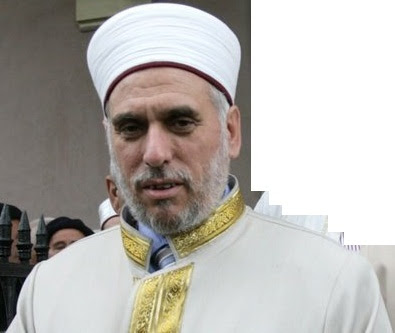There are no official Islamic symbols, but several symbols or images have a special place in Islam.
The Star and Crescent Symbol

The star and crescent is a well-known symbol of Islam. It features prominently on the flags of many countries in the Islamic world, notably Turkey and Pakistan.
Contrary to popular belief, the symbol is not Muslim in origin. Rather, it was a polytheistic icon adopted during the spread of Islam, and its use today is sometimes controversial in the Muslim world.
The crescent and star are often said to be Islamic symbols, but historians say that they were the insignia of the Ottoman Empire, not of Islam as a whole.
It is important to keep in mind that Islam has few traditional symbols, and the crescent moon and star are not ones that are recognized by as traditional symbols by Muslims. The symbol is due to cultral diffusion and the spread of Islam to the Ottoman turks who ruled a large area and also put the crescent moon and star symbol on their flag. It has since become associated with Islam.
Islamic Color Symbolism
In early accounts of Muslim warfare, there are references to flags or battle standards of various colors: black, white, red, and greenish-black. Later Islamic dynasties adopted flags of different colors:
- The Ummayads fought under white banners
- The Abbasids chose black
- The Fatimids used green
- Various countries on the Persian Gulf have chosen red flags
These four colors (white, black, green and red) dominate the flags of Arab states.
The color green has a special place in Islam, and is often used to represent it among other world religions. One can often find it in mosques and other important places, as well as on the flag of Saudi Arabia. Some say green was Muhammad’s favorite color and that he wore a green cloak and turban, while others believe it symbolizes vegetation and life. Some say that after Muhammad, only the caliphs were allowed to wear green turbans. In the Qur'an (Surah 18:31), it is said that the inhabitants of paradise will wear green garments of fine silk. While the reference to the Qur'an is verifiable, it is not clear if other explanations are reliable or mere folklore.
Regardless of its origins, the color green has been firmly cemented in Islamic culture for centuries; for example, it is absent in many medieval European coats of arms, as during the Crusades, green was the color used by the Islamic soldiers. Additionally, in the palace of Topkapi in Istanbul, there is a room with relics of Muhammad. One of the relics, kept locked in a chest, is said to have been Muhammad's banner, under which he had went to battle. Some say that this banner is green with golden embroidery; others say that it is black.
 "Allah" in Arabic |
Other Islamic Symbols
Certain words in Arabic script or characters can be regarded as visually representing Islam, such as "Allah" at the top of this page, or the Shahada.
A Shi'ite symbol is the sword, which is identified with Iimam Ali, who they believe fought with this sword and his life for Islam.
The gardens of the Mughal Empire in India were symbols of paradise (Jannah).
Sources
- Hujjat-ul-llahi-l-Balighah by Shah Wali Ullah Dehlvi
- Wikipedia. 2006. Based on article text but with changes, licensed under GFDL.
Links on Islamic Symbols
- Crescent Moon: Symbol of Islam? - About.com
- The Symbolism of the Number Seven in Islam - Wadsworth Learning










Няма коментари:
Публикуване на коментар